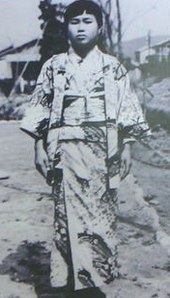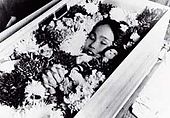Sadako Sasaki
Sadako Sasaki ( Japanese 佐 々 木 禎 子 Sasaki Sadako ; * January 7, 1943 in Hiroshima ; † October 25, 1955 ibid) was a Japanese student and became the world's most famous Hibakusha (survivor of the atomic bombs on Hiroshima and Nagasaki ).
Life
Sadako Sasaki was 2½ years old at the time the US atomic bombs were dropped on August 6, 1945 and grew up as a seemingly healthy, athletic girl. On January 10, 1955, she was diagnosed with leukemia , a cancer that is common among survivors of the atomic bomb.
Sadako's best friend told her of an old Japanese legend that the one who in 1000 Origami - cranes ( 千羽鶴 , Sembazuru fold) by the gods fulfilled a wish would get. Sadako then began to fold paper cranes during her stay in the hospital for several months. After completing 1,000 cranes in less than a month, she continued her work in the hope of a cure. Her brother Masahiro Sasaki speaks of a total of around 1,600 cranes that Sadako folded until she died.
Souvenirs and monuments

Numerous books have appeared on Sadako Sasaki's life story, which has made her story the most internationally famous case of atomic bomb damage. Even today every child in Hiroshima knows their story.
Due to the worldwide spread and sympathy that Sadako Sasaki's story found, origami cranes have become a symbol of the international peace movement and resistance to nuclear war .
In Japan, with the commitments made in Sadako's name donations in 1958 in Hiroshima the nearby Peace Museum and the Atomic Bomb Dome in Peace Park , a surrounded by glass cases Monument, designed by Kikuchi Kazuo the Children's Peace Monument to the winged statue of Sadako, built for the World Children Peace. The boxes are regularly refilled with paper cranes sent from around the world, and a memorial service has been held there every year at the end of July since 1989.
In the USA, in 1990, on the initiative of Floyd Schmoe , the recipient of the Hiroshima Peace Prize in 1988, the Seattle Peace Park was established in Seattle , Washington, near the University of Washington . This Peace Park, for which Schmoe donated his US $ 5,000 prize money, was inaugurated on August 6, 1990, the 45th anniversary of the atomic bombing on Hiroshima, and contains a life-size bronze statue of Sadako Sasaki with an origami crane in his right hand raised . Every year it is visited by hundreds of children who place paper cranes on the statue and thus set a sign of their desire for peace in the world.
On August 5, 2007, the “Abolish Nuclear Weapons” memorial was unveiled in the Hiroshima-Nagasaki Park in Cologne . It shows a symbolic origami crane and commemorates the fate of Sadako Sasaki.
literature
- Masahiro Sasaki: My little sister Sadako. Translated by Mio Aizawa, edited by Ingrid and Christian Mitterecker. Verlag ingridundchristian.at, Heiligenbrunn 2014, ISBN 978-3-903019-00-3
- Ingrid and Christian Mitterecker: Sadako's plan. Verlag ingridundchristian.at, Heiligenbrunn 2016, ISBN 978-3-903019-16-4
- Ingrid and Christian Mitterecker: The crane's gratitude. From Hiroshima to Fukushima. Wieser Verlag, Klagenfurt 2011, ISBN 978-3-85129-944-1
- Karl Bruckner : Sadako will Leben G & G Verlagsgesellschaft, 2005, ISBN 3-7074-0275-4 .
- Eleanor Coerr: Sadako. Altberliner Verlag, 1995. ISBN 978-3-357-00677-2 .
Web links
- Literature by and about Sadako Sasaki in the catalog of the German National Library
- Sadako and the Paper Cranes Virtual Exhibition of the Hiroshima Peace Memorial Museum (English)
Individual evidence
- ↑ A Young Girl's Death from the A-bomb - Sadako Sasaki. Hiroshima Peace Memorial Museum, accessed March 16, 2011 .
- ↑ Masahiro Sasaki: My little sister Sadako . Ed .: Ingrid and Christian Mitterecker. ingridundchristian.at, Heiligenbrunn 2014, ISBN 978-3-903019-00-3 .
- ↑ Till Mayer: Anniversary of the atomic bomb - Hiroshima struggles against oblivion. Spiegel Online , August 6, 2010, accessed March 16, 2011 .
- ↑ Seattle Peace Park is dedicated on August 6, 1990. HistoryLink.org, accessed March 16, 2011 .
| personal data | |
|---|---|
| SURNAME | Sasaki, Sadako |
| ALTERNATIVE NAMES | 佐 々 木 禎 子 (Japanese) |
| BRIEF DESCRIPTION | Japanese schoolgirl, victim of the atomic bombing on Hiroshima |
| DATE OF BIRTH | January 7, 1943 |
| PLACE OF BIRTH | Hiroshima |
| DATE OF DEATH | October 25, 1955 |
| Place of death | Hiroshima |

